HEARING PROTECTORS, HEARING LOSS, AND INTELLIGIBILITY
Readers of my column should by now be used to my predilection for rigorously defining terms that are frequently used in the acoustics side of the field. Let’s keep with that practice and define the terms in the title “Hearing Protectors, Hearing Loss, and Intelligibility,” so that there will be no misunderstandings.
 As per the CSA Standard Z94.2-14, a “hearing protection device (HPD) is a personal device, also referred to as a hearing protector, worn as a barrier to reduce the sound level entering the cochlea (inner ear) in order to diminish the harmful auditory and/or annoying subjective effects of sound.” The reduction of the sound level (“attenuation”) is something that is measured and is in the most recent ANSI standard (S12.6-2008) on this topic. This reduction is also examined in the Canadian standard Z94.2-14 where the methods of measurements as well as the application of the results of the measurement are specified.
As per the CSA Standard Z94.2-14, a “hearing protection device (HPD) is a personal device, also referred to as a hearing protector, worn as a barrier to reduce the sound level entering the cochlea (inner ear) in order to diminish the harmful auditory and/or annoying subjective effects of sound.” The reduction of the sound level (“attenuation”) is something that is measured and is in the most recent ANSI standard (S12.6-2008) on this topic. This reduction is also examined in the Canadian standard Z94.2-14 where the methods of measurements as well as the application of the results of the measurement are specified.
As per Wikipedia, “…hearing loss exists when there is diminished sensitivity to the sounds normally heard. The terms hearing impaired or hard of hearing are usually reserved for people who have relative insensitivity to sound in the speech frequencies.”
Finally, and again as per Wikipedia, “…in speech communication, intelligibility is a measure of how comprehensible speech is in given conditions.” In other words, intelligibility is dependent on many factors, one of them being noise, but it can be measured. The relevant ANSI standard (ANSI 3.5 -1997) specifies how tests are done and how to assess the results. The calculation is not simple since it requires knowledge of the spectra of the speech and the noise, as well as the listeners’ hearing thresholds at the different frequencies.

Many factors influence intelligibility beside the presence of noise. Probably the best known is the distance between speakers – as it increases, the speech sound level decreases and the speakers have to raise their voices to increase intelligibility. The reverberation of the environment where the conversation is held is another important factor: we all have experienced the difficulty of holding a conversation in a reverberant indoor swimming pool, especially if there is noise.
On the other hand, familiarity with the topic of conversation can greatly facilitate intelligibility as are facial clues.
The title of the article contains three terms: hearing protectors, hearing loss, and intelligibility. Put together they refer to a person with hearing loss who wears hearing protectors and who is trying to understand what a person next to him is trying to say. One doesn’t have to be Sherlock Holmes to realize that we are dealing with a worker in a noisy workplace, who is trying to communicate with a co-worker or to understand a message from the public address system. This is a quite a common situation, since most workplaces are noisy, many workers have a degree of hearing loss and all of them are expected to wear hearing protectors.
What happens to the intelligibility in those situations? Hearing protectors and intelligibility in a quiet environment do not mix well. It has been shown that intelligibility decreases with the use of hearing protectors. By how much, depends of the spectrum of the speech and the attenuation of the hearing protector. It is worst with most earplugs used in industry. These have an attenuation pattern that increases with frequency. Since intelligibility is largely dependent on the high frequency content of the speech it is obvious that the person wearing earplugs will have difficulties understanding. This is especially true in an environment with low background noise levels (< 80 dBA).
What is the situation in higher noise level environment, when a person wearing hearing protectors has normal hearing? Both, speech and noise are attenuated by the same amount. The speech to noise ratio remains the same. The result is that in most situations, the protector increases the ability of the wearer to understand speech, because while reducing both levels it allows the cochlea to respond without distortion. In a way, the phenomenon is similar to wearing sunglasses in a bright sunny day: the person can see better and is able to distinguish detail that he couldn’t otherwise.
Let’s introduce the hearing loss effect. Here the speech intelligibility suffers for two reasons: by the attenuation of the hearing protector and by the hearing loss. Both affect the higher end of the frequency spectrum. There is the possibility that the high frequencies of the speech appear below the threshold of sensitivity and are, therefore inaudible. The net result is a reduction in the intelligibility. In other word, a person with hearing loss hears less than a person with normal hearing when both individuals are wearing hearing protectors in a noisy environment.
That brings us to a question, well known by health and safety professionals in the workplace: shall we require people with hearing loss wear hearing protectors? Unfortunately, there is no clear answer to this problem. On one hand, the hearing, even reduced hearing, has to be protected to avoid further deterioration. On the other, depending on the task at hand, oral communication can be an occupational requirement that ensures a safe work environment. Obviously, there is no a unique answer to this question. Each situation has to be examined individually to arrive to a solution that takes into account both requirements: hearing conservation and safety in the workplace.
There is yet another situation which is quite common in our country: the one of a worker with limited knowledge of the language used in their workplace. Even with perfect hearing they still need to hear all the words in a conversation to achieve a decent intelligibility. In this case, a combination of hearing protectors and hearing loss can have a drastic effect on the balance of hearing conservation and safety in the work place.
In summary, care should be taken in a noisy workplace to avoid creating workplace hazard by introducing across the board use of hearing protectors.

